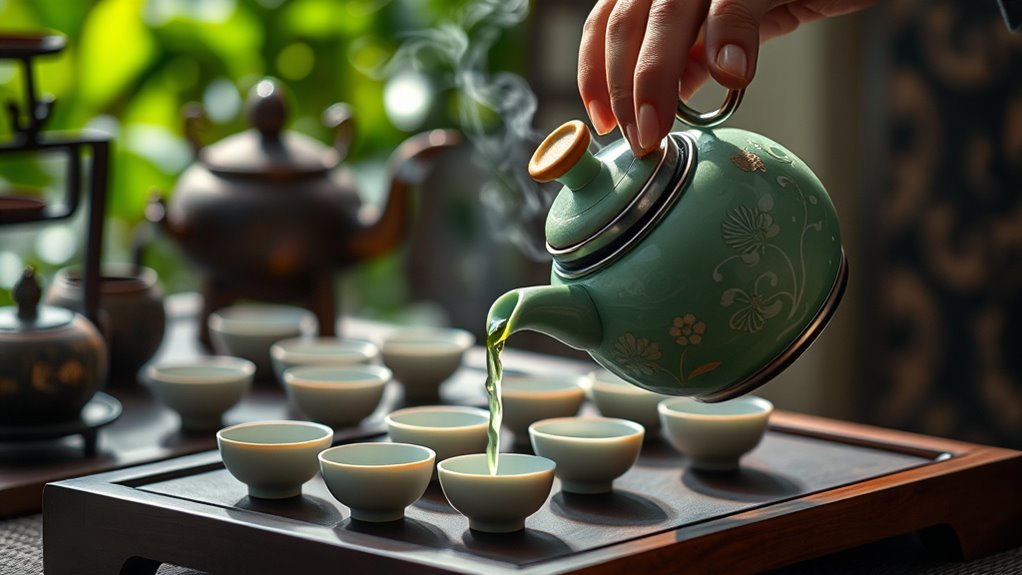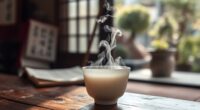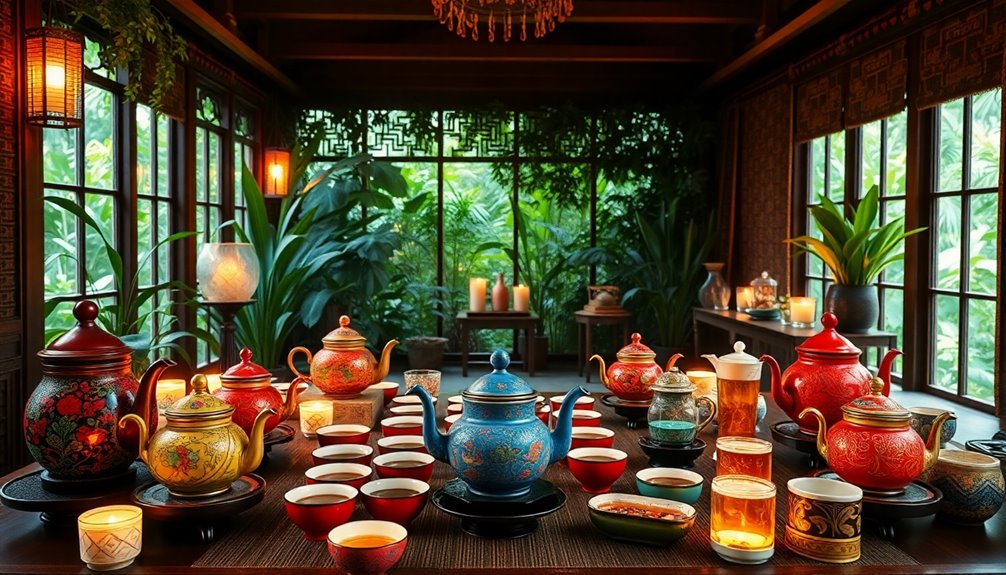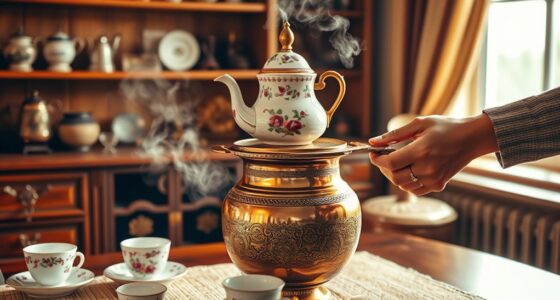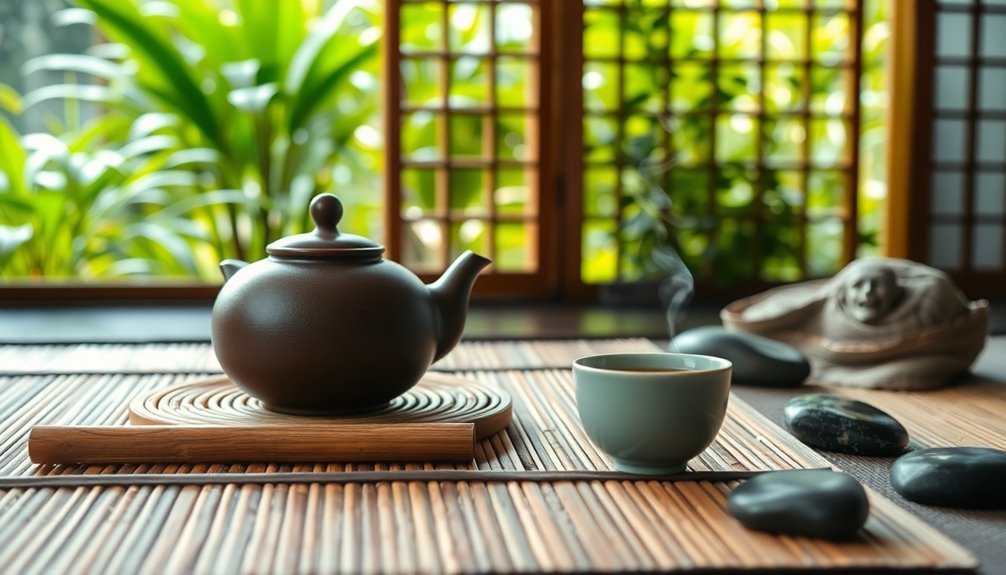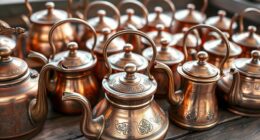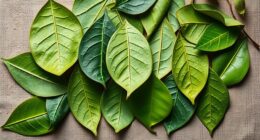To understand the Chinese Gongfu Cha ceremony step by step, you start by preparing your space and selecting high-quality tea leaves. You’ll rinse and warm the teapot and cups to show respect. During the process, handle everything with care, pour water carefully, and focus on aroma and flavor. Each movement reflects mindfulness, harmony, and reverence for tradition. Keep exploring to discover how each detail enhances the cultural and sensory experience of this elegant ritual.
Key Takeaways
- Prepare a clean, serene space and select high-quality, tightly rolled tea leaves for brewing.
- Rinse tea leaves with hot water, warm the teapot and cups, then steep the tea with attentive handling.
- Observe the aroma during steeping, then pour the tea into small cups in a circular motion for even distribution.
- Savor each sip slowly, engaging all senses to appreciate layered flavors, aromas, and the cultural significance.
- Embrace the ritual’s values of respect, mindfulness, harmony, and artistry through precise movements and reverence.
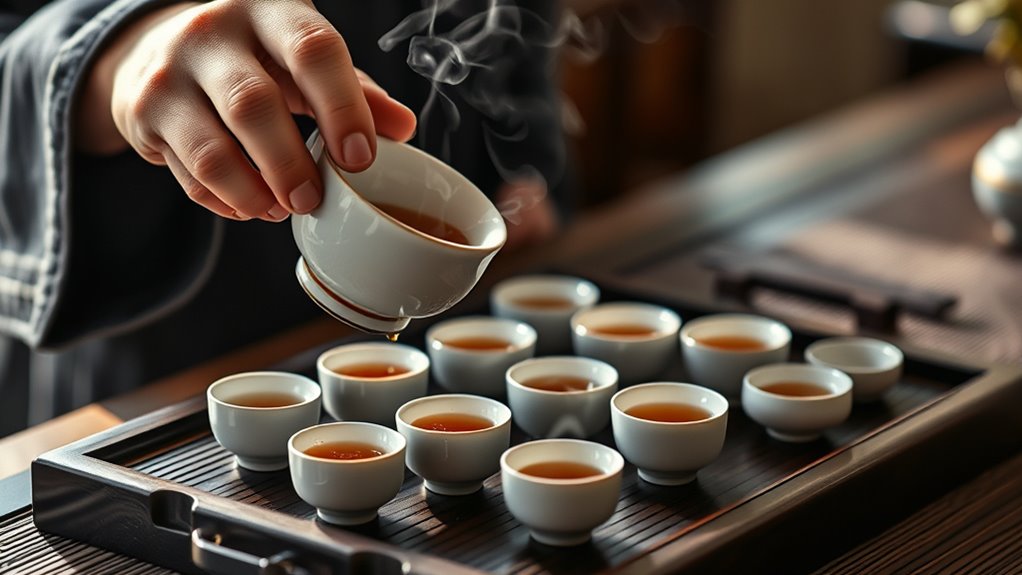
Have you ever wondered what makes the Chinese Gongfu Cha ceremony so special? It’s not just about brewing tea; it’s a rich tradition that embodies respect, mindfulness, and a deep connection to Chinese culture. When you participate in Gongfu Cha, you’re engaging in more than just drinking tea—you’re observing a set of tea etiquette that elevates the experience and reflects the cultural significance behind each step. Every movement, from handling the teapot to pouring the tea, carries meaning and demonstrates reverence for the craft and history.
Gongfu Cha honors tradition through mindful movements, respectful etiquette, and a deep cultural connection with every step.
The process begins with carefully preparing your workspace, ensuring cleanliness and order. You’ll select high-quality tea leaves, often small and tightly rolled, which are essential for the full expression of flavor during the steeping process. As you rinse the leaves with hot water, you’re not only awakening them but also demonstrating respect for the tea and the tradition. The ritual of warming the teapot and cups is a subtle yet meaningful gesture, symbolizing hospitality and mindfulness. These small acts are rooted in tea etiquette, which emphasizes attentiveness and grace, setting the tone for the entire ceremony.
Pouring water with precision and control is *vital*, as it reflects your respect for the tea and the guest or yourself. During the steeping, you may notice the aroma wafting, a sensory experience that enhances your appreciation of the tea’s complexity. When pouring the brewed tea into small cups, you do so gently, often in a circular motion, ensuring even distribution and a smooth experience for everyone involved. The act of sharing tea in small sips fosters connection and mindfulness, reinforcing the cultural significance of harmony and respect that underpins Gongfu Cha.
As you enjoy the tea, you’re encouraged to savor each sip slowly, appreciating the layers of flavor and aroma. This mindful approach exemplifies the deeper meaning behind the ceremony, which is rooted in cultivating patience, gratitude, and harmony. The entire process, from selecting leaves to serving and drinking, emphasizes the importance of etiquette and respect for tradition. By adhering to these practices, you participate in a ritual that honors Chinese history and values, making each tea session a meaningful and culturally enriching experience. Additionally, practicing space and organization can enhance your overall tea experience by creating a serene and focused environment. Through Gongfu Cha, you not only enjoy exceptional tea but also connect with a centuries-old cultural practice that celebrates artistry, discipline, and reverence.
Frequently Asked Questions
What Are the Origins of the Gongfu Cha Ceremony?
You might wonder about the origins of the gongfu cha ceremony. Its history traces back centuries in China, evolving from a practical tea brewing method into a refined art form. The cultural significance lies in its emphasis on patience, respect, and harmony, reflecting Chinese values. This tradition highlights the importance of savoring tea with mindfulness, making it a cherished ritual that connects people and preserves cultural heritage across generations.
How Does Gongfu Cha Differ From Western Tea Brewing Methods?
Gongfu cha differs dramatically from Western tea brewing by emphasizing elegance, effort, and expertise. You use specialized tea utensils like tiny teapots and cups, focusing on precise brewing techniques that extract maximum flavor. Unlike Western methods, which often prioritize volume, gongfu cha champions careful control, quick steeping, and multiple infusions, turning tea time into a tactile, traditional, and transformative ritual that celebrates skill and sensory delight.
What Types of Tea Are Traditionally Used in Gongfu Cha?
In gongfu cha, you typically use traditional tea varietals like oolong, pu-erh, or black teas, chosen for their aromatic qualities and ability to withstand multiple infusions. You’ll brew these teas in small, elegant vessels like gaiwans or yixing clay teapots, which enhance flavor and aroma. These vessels allow you to control the brewing process closely, highlighting the tea’s nuanced characteristics and making each session a refined experience.
Are There Regional Variations in the Gongfu Cha Ceremony Across China?
You’ll find regional variations in the gongfu cha ceremony across China, shaped by local customs and ingredients. In Fujian, for example, you might see lighter, more delicate preparations, while in Guangdong, the focus could be on robust flavors. These differences reflect local tastes and traditions, making each ceremony unique. By embracing regional customs and local ingredients, you deepen your appreciation for the cultural richness behind this elegant tea ritual.
How Can Beginners Properly Prepare for a Gongfu Cha Session?
Well, who needs a master’s touch when you can wing it with tea utensils and water temperature? As a beginner, you should gather quality teaware, like a gaiwan or small teapot, and learn to control water temperature to avoid brewing disaster. Practice patience, measure your leaves, and get familiar with your tools. Soon, you’ll impress even the most seasoned tea drinkers with your newfound gongfu charm.
Conclusion
As you step back from the dance of leaves and steam, you realize the Gongfu Cha ceremony isn’t just about tea—it’s a symphony of patience and grace. Every pour, every sip, weaves a story of tradition and mindfulness, flowing like a gentle river through time. Embrace each moment, let the aroma be your compass, and feel the rhythm of ancient wisdom guiding you. In this quiet dance, you find harmony, one delicate cup at a time.

